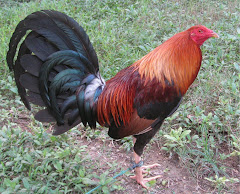
ALABAMA ROUNDHEADS
by H.H Cowan & T.K. Bruner (1924)
This story begins 45 years ago when I was born into the chicken game and which I have played in its every phase. I have bought, fed, fought, heeled and handled cocks of many different strains and crosses, and probably have done as much experimenting as any man of my years. It is my opinion that there is no one best strain of fowl and no one best feeder, but there are many of both in class "A" and when you make a main nowadays for real money you are sure to meet them. It seems the days of monopoly in the cocking game have passed, which I attribute to renewed interest in the sport and the increased flow of money and brains into the game.
I do not claim to have originated the best strain of the pit games in the world in my Alabama Roundheads, but the fact that they have won the majority of their fights and kept pace with the ever-increasing speed of the game for the past twenty years, under all rules and any length of gaff, is very gratifying.
For the past several years I have done most of my fighting at Memphis, Tenn., where my fowl were known as Alabama Cocks, thus theur name Alabama Roundheads. My fowl have passed the experimental stage, having their characteristics inbred into them, and I feel with my system of breeding I can hold them at their present standard for years to come.
Many years ago when Mr. Allen and Mr. Shelton were defeating all opposition with their great strain of Roundheads, I attended just about all the mains and tournaments in which they were entered, forming an acquaintance and finally friendship with Mr. Shelton, as he was a man whom to know was to like, being one of those old time Southern gentlemen-sportsmen who at one time so characterized the gentility of the Old South. In his passing the fraternity lost one of its great uplifters and the South one of its best citizens. Through this association I became familiar with the history and breeding of the Allen Roundheads and secured my first of these from Mr. Shelton, personally, when at their best, and of his best. I fought them pure for a number of years. From my knowledge of the Allen Roundheads they were originated from a Saunders Roundhead cock bred over Col. Grist Grady hens and then bred closely to the Sauders side. I was breeding and fighting these Roundheads continuously each season and it gradually became apparent to me that they were being bred a bit too close to cope with the strong, rough cocks they were having to meet. It is my opinion, from both experience and observation, that the old time Allen Roundheads with their smart side-stepping tactics and phenomenal sparring qualities and rapid straight hip blows while in the air, could best most cocks they met in the early stages of the battle.
I think this excellent quality was their chief asset and enabled them to make one of the best, if not the best, pit records of any Southern strains. But in the latter stages of battle, when it came down to a give-and-take, I have never thought they excelled, and I was convinced that if they were to keep pace with the game and maintain their record they must be bred to fight as efficiently when the battle came down to a "tug of war" as in the beginning of a fight. I made several unsuccessful experiments with this end in view, but I kept on trying and about fifteen years ago I became acquainted with the great characteristics of the old time Mahoney Gull fowl, with their desperate gameness, strong constitutions and deadly heel. These being the qualities I wished to add to the already great fighting qualities of the Allen Roundheads, I decided to make an infusion of this blood. I secured a royally bred Gull cock of the old school, through friendship with a source whence no one has ever been able to buy a feather to my knowledge, and bred him over my Roundhead hens.
The Gulls being a yellow and white leg strain of black breasted reds with few exceptions of medium station, the type and color was only slightly changed from this cross; but the plumage was longer and much improved. The plumage of the Gull fowl is of a marked characteristic, consisting of a very broad feather extremely lomg and with a quill of whale-bone toughness. Such plumage enables a cock to be fought several times during a season in good feathers.
The first cross were strong, tough and desperately game. I bred back to the Roundhead side, fighting and testing them. Each year's breeding showed an improvement over the preceding one, and kept this up until they again were back to the Roundhead type, showing all the old time fighting qualities of the Allen Roundheads, yet this was backed by strength and endurance, making them more efficient cocks at any stage of battle.
It is my experience that any cocks must have the ability and inhibition to go all the way, as well as great scoring or starting, in order to hold their own in cock fighting of the present day. I fought them with fair success a few years and studied them closely, and finally reached the conclusion that their ability to strike rapidly and efficiently from any angle when in close quarters could be improved upon. Knowing this quality to be one of the outstanding characteristics of the Grist Gradys their foundation stock, I made a fresh infusion of this old reliable blood.
I secured a cock that proved to be of the right sort and his produce were deep game and he imparted the quality I had aimed at to a marked degree, without the loss of any other essential quality. Thye proved to be a real combination fighting cocks, efficient at any stage of battle, which their record shows. By inbreeding anfd line breeding to the outstanding individuals for the past 12 years these qualities have been stamped into them, until they come uniform in type and action. The Alabam Roundheads are practically of the same color and type as the Allen Roundheads. Cocks are black breasted reds with white or yellow legs, but a pumpkin or a deep cherry red or a spangle occurs occasionally, as well as both straight and pea-combs. The hens come from light buff to wheaten, occasionally a green or dark legged fowl will appear among the offspring. All these slight variations come honestly from their foundation blood; the green or dark legs from the Redquill in the Gradys, and the straight combs from both the Gulls and Gradys. However, the largest proportion of them come with white and yellow legs, pea-combs and in color black breasted reds.
For the past eight years I have done most of my fighting at Memphis, Tenn., in combination with Bruner and Herron. Bruner doing all the honors in the cock house and pit. I consider him a fine judge of a cock and among the best feeders in the South. He knows what to expect of a cock, and if they had not been right in every respect he would have found it out several years ago and passed them up. He tests nearly every loser and they have to be right for ihm or he has no use for them. He has been breeding the Alabama Roundheads ten years and has greatly assisted me in bringing these fowl to their present state of excellence by his help and advice in selecting brood fowl from the performance of the cocks in the pit. Mr. Bruner has conditioned and fought more of these cocks possibly than any other man, knows them through and through, as he has practically lived in the cock house with them for the past several years.








